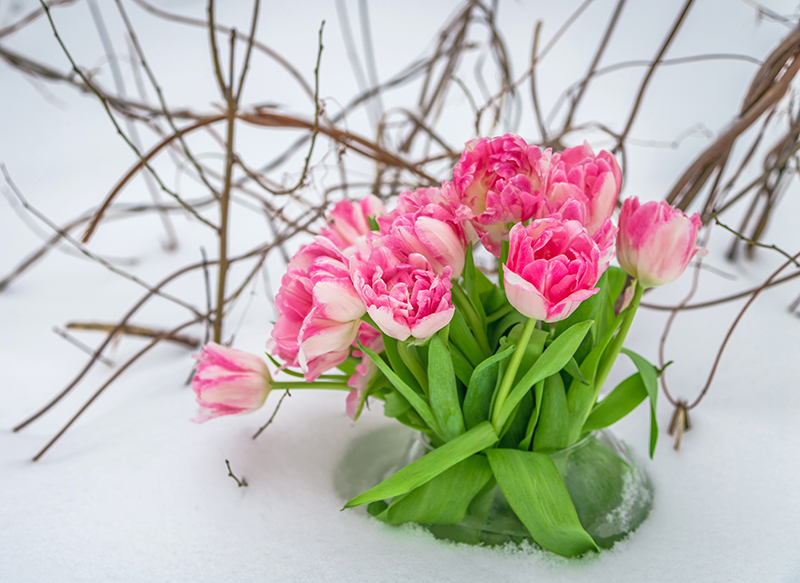Maximizing the Beauty of Your Orchids
Posted on 02/09/2025
Maximizing the Beauty of Your Orchids: The Ultimate Guide
Orchids are among the most adored and exquisite flowers in the world, renowned for their exotic elegance and vibrant blooms. Whether you're an experienced horticulturist or a passionate beginner, learning how to maximize the beauty of your orchids can transform your home or garden into a breathtaking oasis. In this comprehensive guide, we will delve deep into methods that help you bring out the best in your orchid plants. Read on to discover practical tips, expert advice, and the secrets to radiant orchids that will impress all who see them.

Understanding Your Orchids: The Foundation of Orchid Care
Before maximizing orchid beauty, it's essential to understand their unique needs. Orchids make up one of the largest and most diverse plant families (Orchidaceae) with over 25,000 species and more than 100,000 hybrids. The two most popular varieties among enthusiasts are:
- Phalaenopsis (Moth Orchid): Recognized for ease of care and elegant blooms.
- Cattleya: Famed for their large, frilly flowers and intense fragrance.
Each orchid variety may require slightly different care, but certain practices will help enhance their inherent beauty regardless of type.
Key Factors in Enhancing Orchid Blooms
- Light
- Water
- Humidity
- Fertilization
- Repotting
- Pest Control
Let's explore each aspect for maximizing orchid beauty in detail.
Providing Optimal Light: The Key to Radiant Blooms
Light is one of the most critical elements for vibrant orchid flowers. Too little light, and your orchid may refuse to bloom; too much, and the leaves may scorch. Here's how to maximize your orchid's appearance by getting the lighting just right:
- Bright, Indirect Sunlight: Place orchids near an east or south-facing window, ensuring filtered light. Phalaenopsis orchids, for instance, prefer bright but indirect sunlight.
- Avoid Harsh Midday Sun: Direct noon sun can burn leaves. Use sheer curtains to diffuse intense light.
- Artificial Lights: If natural light is inadequate, use grow lights designed for orchids to supplement and encourage blooming year-round.
- Watch the Leaves: Healthy orchid leaves are typically bright green. Yellowish leaves may indicate too much light, while very dark green suggests too little.
Pro Tip: Rotate Your Orchid
Rotating your orchid every few days ensures all sides receive balanced light, fostering even growth and blossoming.
Mastering the Art of Watering: Orchid Care Secrets
The right watering routine can make or break your orchid's beauty. Orchids are epiphytes, meaning they naturally grow on trees in humid forests, absorbing moisture from the air and rainfall. When watering orchids at home:
- Check Before Watering: Never water orchids on a schedule. Always check the potting media's moisture. Stick a finger in the medium — if it feels dry, it's time to water.
- Use Lukewarm Water: Room temperature water is ideal. Ice cubes can damage sensitive roots.
- Draining is Crucial: Ensure pots have drain holes. Orchid roots hate standing in water and can rot easily.
- Water Early in the Day: Watering in the morning allows leaves to dry, reducing risks of fungal diseases and maximizing orchid health.
Watering Frequency by Environment
- Regular Indoors: Typically once a week, but always check the medium first.
- High Humidity: Water less frequently, as the air moisture helps hydrate the plant.
- Dry Air: Increase watering or misting, especially in winter when heating dries air.
Humidity and Air Circulation: Creating a Lush Environment
Many orchids thrive in humidity levels between 40-70%. Without enough humid air, buds may drop, and leaves can wither, reducing the beauty of your orchids. Here's how to create the perfect micro-environment:
- Humidity Trays: Place the orchid pot above a shallow tray lined with pebbles and filled with water. This raises humidity around the plant but prevents root rot.
- Group Orchids Together: Multiple plants together create a humid "micro-climate."
- Regular Misting: Lightly mist orchid leaves (not flowers) using a spray bottle for an instant humidity boost.
- Use a Humidifier: Especially helpful in dry, heated homes.
- Good Airflow: Make sure there's gentle air movement to prevent mold. A small fan nearby works wonders.
Fertilization: Nourishing Your Orchids for Spectacular Blooms
Nutrient-deficient orchids seldom bloom to their potential. Feeding your orchids correctly is vital:
- Use Orchid-Specific Fertilizers: These contain the right balance of nitrogen, phosphorus, and potassium for optimal growth and flowers.
- "Weakly, Weekly": Dilute fertilizer to a quarter of recommended strength and apply weekly when the plant is actively growing or blooming.
- Rinse Monthly: Periodically rinse the potting media with plain water to flush away excess salts which accumulate over time and prevent root burn.
- Pause Fertilizer in Dormancy: When orchids finish blooming and growth slows, reduce feeding until new growth reappears.
Bonus Tip: Orchid Bloom Enhancers
Some commercial products are formulated to stimulate flower spikes and boost bloom size. Use these sparingly for maximizing orchid magnificence!
Repotting for Renewed Vigor and Beauty
Over time, orchid roots become cramped, and the growing media breaks down, inviting disease and hampering flower production. Repotting is essential for maximizing the longevity and appearance of your orchid plants:
- When to Repot:
- Every 1-2 years, or when potting media decomposes
- When roots overgrow the pot or circle inside tightly
- After blooms have faded
- How to Repot:
- Trim dead or mushy roots with sterile scissors
- Use fresh, chunky orchid bark or sphagnum moss
- Avoid deeply burying the base (crown) of the orchid
- Benefits: Healthy roots maximize water and nutrient uptake, enhancing growth and blossoming.
Pruning and Grooming: Maintaining Orchid Allure
Regularly pruning and cleaning your orchids not only prevents disease but also keeps them looking pristine:
- Remove Spent Flowers: Carefully snip off faded blooms to encourage the plant to redirect energy into new flowers.
- Trim Old Stems: For Phalaenopsis, cut flower spikes just above a node to possibly encourage a second bloom.
- Wipe Down Leaves: Dust dulls leaves and blocks light. Wipe them gently with a damp cloth or cotton pad.
- Cut Away Dead Leaves: Always use sterile tools to prevent infection.
Pest and Disease Management: Keeping Orchids Flawless
Pests and diseases can quickly mar your orchids' beauty. Be vigilant and act quickly at the first sign of trouble:
- Common Orchid Pests:
- Mealybugs (white, cottony masses)
- Scale (shell-like structures on leaves and stems)
- Aphids
- Spider mites (webbing and tiny specks)
- Simple Fixes:
- Isolate affected plants immediately
- Wipe pests off with isopropyl alcohol on a cotton swab
- Use insecticidal soap or neem oil as a natural solution
- Fungal and Bacterial Diseases: Improve airflow and reduce overwatering; apply fungicides when necessary.
Inspect your orchids every week to protect their show-stopping beauty and keep them healthy year-round.
Maximizing Orchid Flowers: Expert Tips for Spectacular Blooms
To truly maximize the beauty of your orchids, consider these additional expert-driven tips:
- Respect Dormancy Cycles: Some orchids, like Dendrobium and Cattleya, require a resting period to trigger blooming. Let the plant "rest" by reducing water, fertilizer, and temperature for a few weeks.
- Mimic Natural Conditions: For tougher-to-bloom orchids (e.g., Cymbidiums, Oncidiums), simulate temperature drops at night to encourage flower spikes.
- Avoid Disturbing Buds: When buds appear, limit moving or rotating the plant to prevent the developing flowers from dropping.
- Choose the Right Pot: Clear plastic pots let you monitor roots and moisture, aiding both appearance and health.
Creating Stunning Orchid Displays
- Decorative Containers: Display orchids in stylish outer pots that complement your home while always ensuring proper drainage.
- Group by Variety: Arrange multiples of a single orchid type for dramatic, color-coordinated displays.
- Mix and Match: Place contrasting orchid colors and types together for a vibrant, eye-catching effect.
- Use Natural Materials: Accentuate with moss, bark chips, or stones for a natural, elegant look.
Photographing Your Gorgeous Orchids
Show off your beautiful orchids by photographing them in natural light, with a soft background that accentuates their delicate features. Share your orchid success on social media or with friends and family!

FAQs About Maximizing the Beauty of Orchids
- Q: Why aren't my orchids blooming?
A: Insufficient light, overwatering, old potting medium, or lack of fertilizer are common reasons. Review the sections above to troubleshoot. - Q: How long do orchid blooms last?
A: Depending on the species, flowers can last from 2 weeks to 4 months with proper care. - Q: Can I grow my orchids outdoors?
A: Orchids can thrive outdoors in warm, humid climates, but must be protected from direct midday sun, wind, and frost. - Q: What's the best way to display orchids for maximum beauty?
A: Arrange in groups, use attractive pots, and accessorize with natural materials for a stunning orchid display.
Conclusion: Unleash the Full Potential of Your Orchids
Orchids are more than just plants—they are living art. By understanding their unique needs and providing attentive care, you can maximize the beauty of your orchids and enjoy lush, vibrant blooms year after year. Remember:
- Give them bright, indirect light
- Water thoughtfully and never let roots sit in water
- Maintain humidity and airflow
- Fertilize for robust flowers
- Repot for healthy roots and continued blossoming
- Watch for pests and diseases
- Showcase your orchids with style
With dedication and insight, your orchids will not only survive but thrive, gracing your space with exceptional beauty and elegance for years to come.







